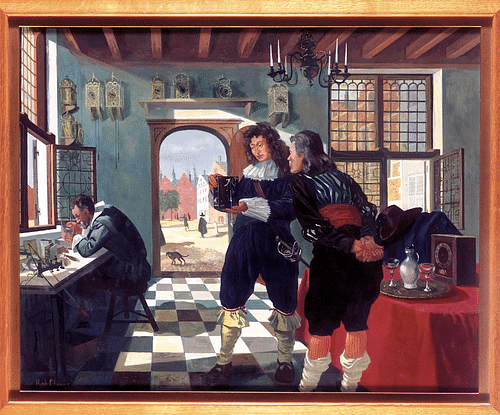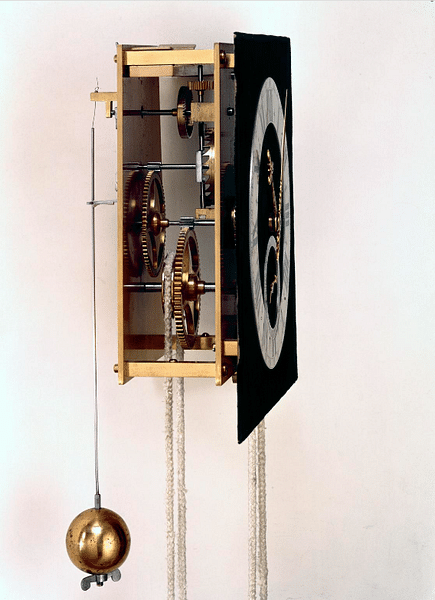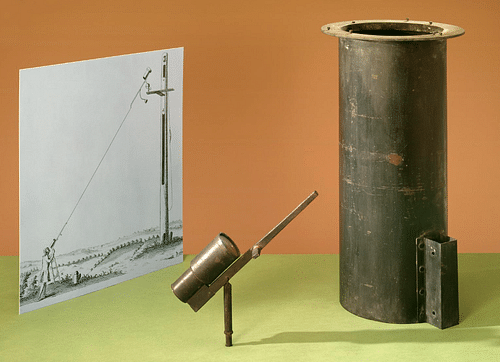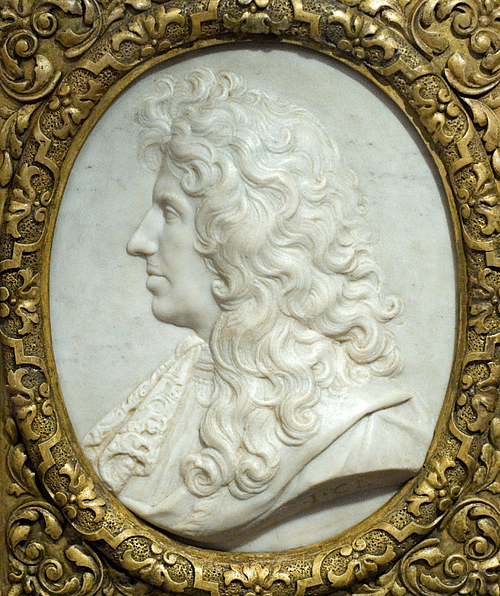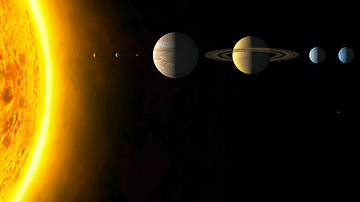
Christiaan Huygens (1629-1695) was a Dutch mathematician, physicist, and astronomer. A leading figure of the Scientific Revolution, Huygens combined research into mathematical-based theories, such as the movement of light waves, with practical projects, like building superior telescopes and watches using balance springs. Huygens is credited with building the first working pendulum clock and first identifying the rings of Saturn.
Early Life
Christiaan Huygens was born in The Hague, the Netherlands, on 14 April 1629. Members of his family had held senior positions in the civil service for some generations. Christiaan's father, Constantijn (1596-1687), was secretary to the leader of the Dutch Republic. Christiaan was educated privately in the family home before he moved on to the University of Leiden, where he studied law and mathematics from 1645. He did not complete his degree, but his family's wealth meant he never needed to work for a living. Free to pursue his scientific interests and encouraged to do so by his father, Huygens first concentrated on mathematics and solving problems of geometry before exploring ways to improve the instruments that astronomers relied upon for their work.
Huygens & Saturn
Huygens, along with his brother Constantijn (1628-1697), designed and manufactured high-quality instruments such as microscopes. The Netherlands, in general, at that time was famed for its manufacturers of high-quality lenses. Huygens was interested in astronomy, and to that end, he developed improvements to existing telescopes using Dutch-made lenses. Huygens put his new instruments to very good use. In 1658, he presented a paper on Saturn's rings in a meeting attended by dignitaries from the French church and state at the Montmor Academy. Three years earlier, Galileo Galilei (1564-1642) had noted something odd about Saturn – what appeared to be appendages on either side of the planet – but his telescope was not good enough to pick out the rings; Huygens' instrument was. Huygens was also the first to clearly spot Titan, one of the moons of Saturn. Huygens would return to the night skies later in his career, but first, he turned his attention to the challenge of how to measure time more accurately than had ever been done before.
The Pendulum Clock
Galileo might have been the first to envisage more accurate clocks using a pendulum instead of a balance wheel, but it was Huygens who made the first working example in 1657 (although fellow Dutchman Salomon Closter, whom Huygens had earlier collaborated with on his pendulum clock, had done the same at around the same time). Huygens presented his pendulum clock to the wider scientific world in his Horologium (1657), the preface of which gave credit to Galileo for his original idea. Pendulum clocks dramatically increased accuracy so that timepieces lost only 10 or 15 seconds each day compared to 15 minutes in non-pendulum models. The invention revolutionised timekeeping and made a whole raft of scientific experiments possible now that more precision could be acquired.
Another work on pendulum clocks followed in 1673, Horologium Oscillatorium. Here, Huygens presented "a masterly mathematical analysis of the cycloid, the curve traced by a point on the rim of a wheel as it rolls on a horizontal surface…the mathematical properties of the curve meant that it ensured the perfectly regular swing of the pendulum of his clock" (Jardine, 332).
The improved accuracy of pendulum clocks was still not good enough to solve the problem of mariners who needed to determine their longitude by accurately measuring time. In any case, a pendulum would not work at sea, given the rolling motion of a ship. There was also the problem that humidity at sea could greatly affect the delicate moving parts of clocks. These problems did not stop Huygens trying out a sophisticated pendulum model with a sort of caged pendulum in sea trials in the 1660s. In 1665, Huygens even published a handy manual for mariners to use his clock, Instructions Concerning the Use of Pendulum-Watches for Finding the Longitude at Sea. The clock was not a success, though.
Huygens and his fellow Dutch clockmaker Johannes van Ceulen tried again to solve the longitude problem in the 1680s. They persuaded the Dutch East India Company (VOC) to fund the construction of a working pendulum model in 1682. The directors of the VOC realised that better navigation meant shorter sailing times, which meant more money could be made and less wasted. It took three years to make the clock, which was then tested at sea in 1685, 1686, and 1690 (all the way from the Netherlands to the Cape of Good Hope). Alas, the trials were deemed unsatisfactory and the clock too sensitive to the movements of the sea. Huygens was never able to create his perfect pendulum since it wore out its parts too fast and so was simply not practical with 17th-century materials.
The Marine Chronometer
While never quite giving up on the pendulum clock, Huygens simultaneously had a stab at building an accurate handheld chronometer in the mid-1670s using the new idea of a balance spring. When Huygens first sketched his spring-powered watch, he wrote in his diary, "Eureka – I have found it" (Jardine, 144). Unfortunately, he then got involved in a priority dispute concerning the watch spring mechanism with the English scientist and notorious litigator Robert Hooke (1635-1703). Huygens had noted in his diary exactly when he made his breakthrough with his balance spring: 23 January 1675. Hooke claimed he had had the original idea back in 1658 but had not put it to practical use. To prove this, he also built a spring-driven clock in 1675. It is possible that mutual associates had communicated Hooke's idea to Huygens. On top of that, a third inventor, Isaac Thuret, a Parisian watchmaker, also claimed to have developed a new type of watch. Huygens had employed Thuret to make a model of his invention, and so the Frenchman's claim to priority was highly dubious. This unfortunate situation illustrates that, in this period, it was not enough to invent something, but one had to be seen to be the first to do so to gain wider recognition. In the end, the balance spring improved accuracy and reduced the size of clocks, but it was still not good enough for navigation where two or three seconds out made for large differences in geography. The spring-powered pocket watch did become very popular with landlubbers, but neither Huygens nor Hooke made very much money from what had become a public idea that any decent watchmaker could put into reality. The longitude problem, meanwhile, was not finally solved until 1770 and the arrival of Harrison's marine chronometer, invented by John Harrison (1693-1776).
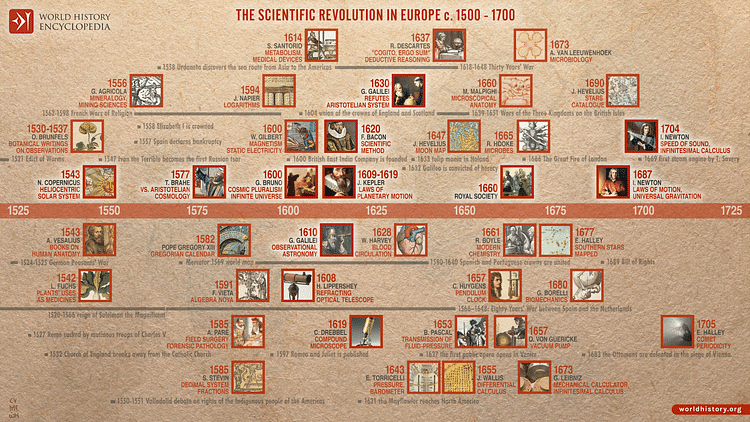
As well as possessing an impressive grasp of mathematics, Huygens was the great practical instrument maker. He also tinkered with air pumps, the only man to do so with any degree of success besides that man again, Hooke. Huygens' assistant with his pump experiments was the Frenchman Denis Papin (1647-1713), who went on to greater things and devised the precursor for the pressure cooker, a device that got later inventors thinking about the possibility of harnessing steam to power an engine.
The Aerial Telescope
Another precision scientific instrument Huygens took great interest in was the aerial telescope. The idea was to use a refracting telescope design, but instead of putting the lens and mirror inside a long tube to separate them, Huygens did away with the tube altogether. With a lens placed on a tall structure like a building or tree and the other on the ground, a much sharper image could be achieved than by using a tube telescope. The aerial telescope built by Huygens in 1686 was massive. The distance between the lenses, the focal length, was 67 metres (210 ft), which made it the world's largest telescope at the time. Huygens' ideas on telescopes were published in 1684 in his Astroscopia Compendiaria. He donated his aerial telescope to the Royal Society, and the various lenses and eyepiece can today be seen in the Science Museum in London.
International Recognition
Huygens visited the Royal Society in London in 1661, and he was made a fellow in 1663, one of the first foreigners to be made so. Several of Huygens' papers were published in the unofficial magazine of the Royal Society, Philosophical Transactions.
Huygens lived in Paris from 1666 to 1681. He was made a fellow of the Royal Academy of Sciences in Paris (Académie des Sciences, founded in 1666), the first foreigner to be so appointed (along with Gian Domenico Cassini). His fellowship meant that he was given a salary for his research and an impressive pension of 5,000 livres when the time came. This was not unusual since Louis XIV of France (r. 1643-1715) specifically wanted to attract Europe's finest minds to his academy. However, the policies of Louis XIV became increasingly anti-Protestant – as evidenced in his revocation of the Edict of Nantes a few years later – and so in 1681, Huygens returned to the Netherlands, living for the rest of his life in The Hague.
Theories of Light & Gravity
In 1690, Huygens published his Treatise on Light. Herein, he presented his "theory that describes light as a wave that is emitted from the particles of an object, setting off a series of additional waves. These waves are carried through an ether composed of particles" (Burns, 226). Today, the Huygens principle of light is still valid. The principle states that light "impulses follow one another irregularly…an infinity of spherical impulses, each originating from a different point along the initial disturbance" (Bynum, 235). What Huygens did not realise, but later scientists discovered, was that the different colours of light (the spectrum) each travel on their own wavelength, and this explains why light can be manipulated by exterior bodies, such as is seen in refraction through a lens or rain drops. Huygens did correctly hypothesise that white light need not be made up of the full spectrum of colours but could be made up of certain pairs, for example, blue and yellow.
Huygens was a not entirely orthodox Cartesian mechanical philosopher (for whom all natural phenomena must be reduced to motion and matter), and he doubted Isaac Newton's pioneering work on gravity since the British scientist could not explain the cause of gravity, only its effects. Huygens and Newton met in London in 1689. Instead of Newton's theory of universal gravity, which had no cause, Huygens presented a counter model of gravity in his Discours de la cause de la pesanteur (Discourse on the Course of Gravity), published in 1690. Here, Huygens "proposed that the particles responsible for gravity circle the earth in all directions, around the poles as well as around the equator; and around any other great circle drawn on the surface of the earth" (Henry, 76-7).
Death & Legacy
Towards the end of his life, Huygens wrote a simplified overview of Cartesian philosophy, Kosmotheoros or The Celestial Worlds Discovered, published posthumously in 1698. Less-Cartesian was Huygens' theories on impact and centrifugal force, for which he developed new algebraic formulas. Huygens suffered ill health in his final years, and he died in The Hague on 8 July 1695. In his will, the scientist left his papers to the University of Leiden. The Dutchman had revolutionised timekeeping, built a lasting theory of light, and shown what better telescopes might achieve with his observations of Saturn. The European Space Agency landed a craft on Saturn's Titan in 2005; that craft was named after Huygens.
